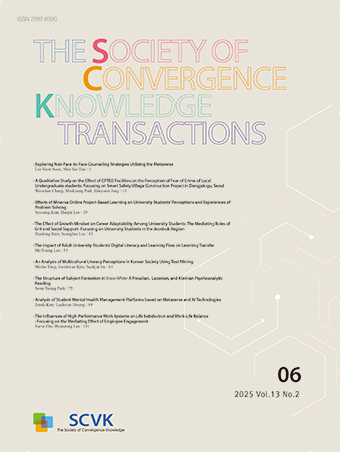Research Article
Abstract
References
Information
주가 예측 시 가장 큰 장애 요인은 거시 환경 및 시장의 변동성이라 할 수 있겠다. 이론적으로 주가의 무작위성은 딥러닝 알고리즘으로 어느 정도 해소가 가능하지만, 주가를 둘러싼 거시 환경과 시장의 급변과 같은 외부 충격은 주가 예측을 어렵게 만드는 요인이며, 이를 어떻게 해소하는가 하는 것이 주가 예측의 관건이라 할 수 있겠다. 이에 전통적인 기술적 지표나 거시 경제 지표 뿐만 아니라, 시장에 충격을 주는 상황을 이해하기 위한 뉴스 정보나 투자자들의 심리를 반영하기 위해서 주식 종목 관련 단어검색, SNS 주식 커뮤니티에서의 감성 분석 등을 통하여 해결하고자 하는 추세이다. 따라서 본 연구의 목적은 주가에 영향을 미치는 내부 요소와 외부 요소들을 모두 이용하여, 주가 예측 요소의 조합을 통해 보다 높은 예측력을 만드는 딥러닝 모델을 찾는 것이다. 딥러닝 알고리즘으로는 시계열 데이터 학습에 적합한 LSTM을 사용하였으며, 딥러닝 실험 결과 예상대로 모든 종목에 적용할 수 있는 범용 모델은 찾을 수 없었지만, 업종이나 가격대 등에 따라 예측력을 높이는 조합이 존재하며, 현재 시점에서 먼 과거의 데이터보다는 최근의 데이터가 예측력을 높인다는 결과가 나왔다.
In predicting stock prices, the biggest obstacle is macro-environment and market volatility. Randomness of stock prices can be resolved to some extent with deep learning algorithms, but external impacts such as the macro-environment surrounding stock prices and rapid changes in the market are factors that make it difficult to predict stock prices, and how to resolve them is the key to the stock price prediction model. Existing stock price prediction research has often used technical indicators. Recently, macroeconomic indicators have also been taken into consideration, and in order to understand the market impact, news information or investor psychology is reflected. There is also a trend to analyze sentiment in the stock community. Therefore, the purpose of this study is to find a deep learning model that uses both internal and external factors that affect stock prices and creates higher predictive power through the inclusion of specific factors or combinations of factors. As a deep learning algorithm, LSTM suitable for time-series data learning was used. As a result of deep learning experiments, it does not seem possible to find a general-purpose model that can be applied to all stocks, but there are combinations of factors that increase the predictive power depending on the industry or price range, and results also shows that the recent data had better predictive power than the past data.
- J. Heo, and J. Yang, "SVM Based Stock Price Forcasting Using Financial Statements", KIISE Transactions on Computing Practices, Vol. 21, No. 3, pp. 167-172, 2015.https://doi.org/10.5626/KTCP.2015.21.3.167
- G. Nam, J. Jang, H. Oh, and T. Kim, "Development of Stock Investment System Using Machine Learning", Proceeding of Information Processing Society Fall Conference, Vol. 24, No. 2, pp. 810-812, 2017.
- A. Siripurapu, "Convolutional Networks for Stock Trading", Stanford University, 2015.
- I. Joo, and S. Choi, " Stock Prediction Model Based on Bidirectional LSTM Recurrent Neural Network", Journal of Korea Institute of Information, Electronics, and Communication Technology, Vol. 11, No. 2 , pp. 204-208, 2018.
- J. Jung, and J. Kim, "A Performance Analysis by Adjusting Learning Methods in Stock Price Prediction Model Using LSTM", Journal of Digital Convergence, Vol. 18, No. 11, pp. 259-266, 2020.
- S. Hong, "A Research on Stock Price Prediction Based on Deep Learning and Economic Indicators", Journal of Digital Convergence, Vol. 18, No. 11, pp. 267-272, 2020.
- D. Shin, K. Choi, and C. Kim, "Deep Learning Model for Prediction Rate Improvement of Stock Price Using RNN and LSTM", Journal of KIIT, Vol. 15, No. 10, pp. 9-16, 2017.https://doi.org/10.14801/jkiit.2017.15.10.9
- T. Fischer, and C. Krauss, " Deep Learning with Long Short-Term Memory Networks for Financial Market Predictions", European Journal of Operational Research, Vol. 270, No. 2, pp. 654-669, 2018.https://doi.org/10.1016/j.ejor.2017.11.054
- Y. Cho, K. Sohn, and O. Kwon, "Comparison of Models for Stock Price Prediction Based on Keyword Search Volume according to the Social Acceptance of Artificial Intelligence", Journal of Intelligence and Information Systems, Vol. 27, No. 1, pp. 103-128, 2021.
- M. Kim, J. Ryu, D. Cha, and M. Sim, "Stock Price Prediction Using Sentiment Analysis: from "Stock Discussion Room" in Naver", The Journal of Society for e-Business Studies, Vol. 25, No. 4, pp. 61-75, 2020.
- M. Zeng, X. Leng, and G. Zhai, "Twitter Mood Predicts the Stock Market", Journal of Computational Science, Vol. 2, No. 1, pp. 1-8, 2011.https://doi.org/10.1016/j.jocs.2010.12.007
- E. Jang, "LSTM Combination of BERT Sentiment Analysis and Time Series Macroeconomy Index for Predicting Stock Price", Master Thesis, Korea University, 2020.
- N. Seong, and K. Nam, "Combining Macro-Economical Effects with Sentiment Analysis for Stock Index Prediction", Entrue Journal of Information Technology, Vol. 16, No. 2, pp. 41-54, 2017.
- S. Siami-Namini, N. Tavakoli, and A. Namin, "A Comparison of ARIMA and LSTM in Forecasting Time Series", In 17th IEEE International Conference on machine Learning and Applications (ICMLA), pp. 1394-1401, 2018.https://doi.org/10.1109/ICMLA.2018.00227
- F. Qian, and X. Chen, "Stock Prediction Based on LSTM under Different Stability", In 4th IEEE International Conference on Cloud Computing and Big Data Analysis (ICCCBDA), pp. 483-486, 2019.https://doi.org/10.1109/ICCCBDA.2019.8725709
- S. Goel, J. Hofman, S. Lahaie, D. Pennock, and D. Watts, "Predicting Consumer Behavior with Web Search", Proceedings of the National Academy of Sciences, Vol. 107, No. 41, pp. 17486-17490, 2017.https://doi.org/10.1073/pnas.1005962107PMid:20876140PMCid:PMC2955127
- FnGuide, https://www.fnguide.com
- Publisher :The Society of Convergence Knowledge
- Publisher(Ko) :융복합지식학회
- Journal Title :The Society of Convergence Knowledge Transactions
- Journal Title(Ko) :융복합지식학회논문지
- Volume : 9
- No :4
- Pages :189-198
- DOI :https://doi.org/10.22716/sckt.2021.9.4.055




 The Society of Convergence Knowledge Transactions
The Society of Convergence Knowledge Transactions







